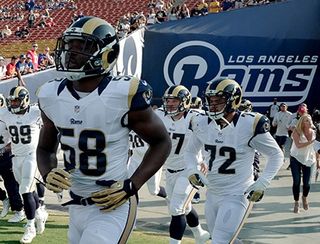For the NFL, Change Is in the Air

Related: McDonough Ready to Leave His Mark on ‘MNF’
They say change is the only constant in life. Nowhere is that more true than with the NFL—at least the version shown on TV.
Between new faces in both the broadcast booth and studio desks, an unconventional new game rights partner in Twitter and a return to Los Angeles for the Rams, the 2016 season, kicking off Sept. 8, will feature some significant tweaks.
One of the biggest: The NFL’s ever-changing Thursday Night Football gets its most ambitious makeover this season.
As the NFL attempts to squeeze every last penny out of its limited inventory, the league decided to split the games between CBS— which had shared TNF with NFL Network the last two years—and NBC. While the two broadcast nets certainly enjoy the additional revenue that five more NFL games will offer, it can create a headache for production teams that are expected to produce two high-quality broadcasts within a five-day span.
NBC even attempted to alleviate the two-games-a-week strain on 71-year-old play-byplay man Al Michaels when it poached Mike Tirico, who called Monday Night Football for ESPN for the last 10 years. It had been widely expected that Tirico would serve as NBC’s TNF announcer, as well as the heir apparent to Michaels, whose contract runs out in 2018. But the NFL rebuffed NBC’s attempt at succession planning, citing CBS’ use of its top broadcast team for TNF broadcasts.
“We’ve spent a great deal of the season working on a daily hour-by-hour schedule to maximize the preparation for both games,” said SNF executive producer Fred Gaudelli, who will serve in the same capacity for TNF. “We already worked seven days per week on Sunday Night Football. So it’s not a question of working harder, it’s a question of can you be great two nights a week with less prep time for both games?”
Broadcasting & Cable Newsletter
The smarter way to stay on top of broadcasting and cable industry. Sign up below
The league is also using TNF to experiment with live-streaming games, following last year’s one-off with Yahoo, allowing Twitter to carry the streams that NBC and CBS will broadcast.
Though live sports is often credited as the load-bearing column keeping the traditional TV industry upright, the past year has proven that even they are not immune to cord-cutting. “Live streaming is without a doubt the big future opportunity,” said Dom Curran, U.S. CEO of sports marketing at sponsorship agency Synergy. “The NFL is smart to get into that.”
But that also means each of those 10 TNF games—NFL Network still gets eight exclusive broadcasts per its carriage deals—will be carried by two networks plus Twitter, which could result in an even higher degree of audience fragmentation. “It’s going to be a large extent used in a mobile capacity, where people might not have access to a TV set or if they don’t have a cable or satellite subscription,” CBS Sports chairman Sean McManus said during a conference call last week. “We really don’t know what the effect is going to be, quite frankly.”
Since Twitter is simply simulcasting the TV broadcast, it will carry all of the national ads that CBS and NBC sell, leaving the social media platform only the local ad inventory as well as integrations around their stream to sell. “From an ad standpoint it’s definitely additive, because the same ads will run in the Twitter feed, which means that our advertisers will get incremental exposure,” said McManus. He admitted they still have to figure out how to measure Twitter’s audience in comparison to TV, since TV and digital have vastly different metrics when it comes to audience. “Digital properties sometimes use something as small as three seconds [to count a viewer], which is obviously not as comparable,” McManus noted.
No trade any team made this offseason was bigger than the Rams’, which relocated from St. Louis to Los Angeles, putting the league back in the country’s second-biggest media market after a two-decade absence. And while the St. Louis teams had their moments—notably one Super Bowl title—the Rams have a 50-year history in L.A., having played there from 1946-1994. The Rams will play in the Los Angeles Coliseum for the first three seasons before moving to a new state-of-the-art facility in nearby Inglewood.
And with a dearth of Super Bowl hosts on the West Coast—only Santa Clara’s Levi’s Stadium and Arizona’s University of Phoenix Stadium are considered suitable by the NFL—the Rams’ new home becomes a yearly contender; it’s already been awarded the 2021 game.
